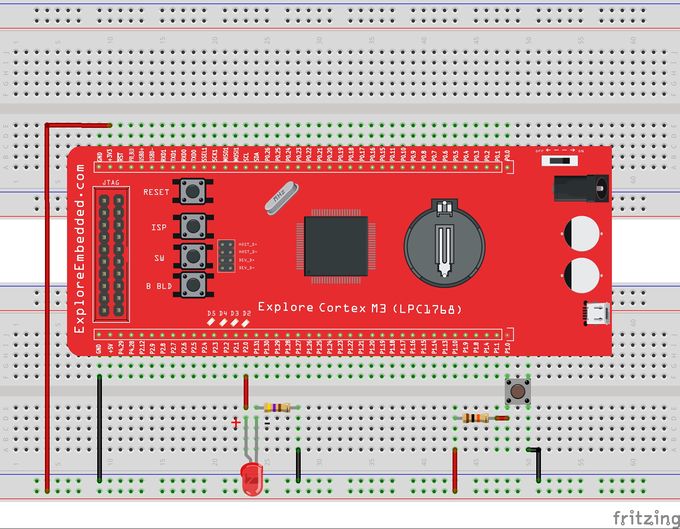LPC1768: Switch and LED
LPC1768: Switch and LED
Register Configuration
The Below registers will be used for Configuring and using the GPIOs registers for sending and receiving the Digital signals.
PINSEL: GPIO Pins Select Register
Almost all the LPC1768 pins are multiplexed to support more than 1 function. Every GPIO pin has a minimum of one function and max of four functions. The required function can be selected by configuring the PINSEL register. As there can be up to 4 functions associated with a GPIO pin, two bits for each pin are available to select the function. This implies that we need two PINSEL registers to configure a PORT pins. By this the first 16(P0.0-P0.16) pin functions of PORT0 can be selected by 32 bits of PINSELO register. The remaining 16 bits(P0.16-P0.32) are configured using 32bits of PINSEL1 register. As mentioned earlier every pin has max of four functions. Below table shows how to select the function for a particular pin using two bits of the PINSEL register.
| Value | Function | Enumeration |
| 00 | Primary (default) function, typically GPIO port | PINSEL_FUNC_0 |
| 01 | First alternate function | PINSEL_FUNC_1 |
| 10 | Second alternate function | PINSEL_FUNC_2 |
| 11 | Third alternate function | PINSEL_FUNC_3 |
FIODIR:Fast GPIO Direction Control Register.
This register individually controls the direction of each port pin.
| Values | Direction |
| 0 | Input |
| 1 | Output |
FIOSET:Fast Port Output Set Register.
This register controls the state of output pins. Writing 1s produces highs at the corresponding port pins. Writing 0s has no effect. Reading this register returns the current contents of the port output register not the physical port value.
| Values | FIOSET |
| 0 | No Effect |
| 1 | Sets High on Pin |
FIOCLR:Fast Port Output Clear Register.
This register controls the state of output pins. Writing 1s produces lows at the corresponding port pins. Writing 0s has no effect.
| Values | FIOCLR |
| 0 | No Effect |
| 1 | Sets Low on Pin |
FIOPIN:Fast Port Pin Value Register.
This register is used for both reading and writing data from/to the PORT.
Output: Writing to this register places corresponding values in all bits of the particular PORT pins.
Input: The current state of digital port pins can be read from this register, regardless of pin direction or alternate function selection (as long as pins are not configured as an input to ADC).
Note:It is recommended to configure the PORT direction and pin function before using it.
Hardware Connections
Examples
Example 1
In this program, we are going to do both INPUT and OUTPUT operation. The port pin to which switch is connected is configured as Input and the pin to which LED is connected is configured as OUTPUT. Here the switch status is read and accordingly the LED will be turned ON/OFF.


No comments